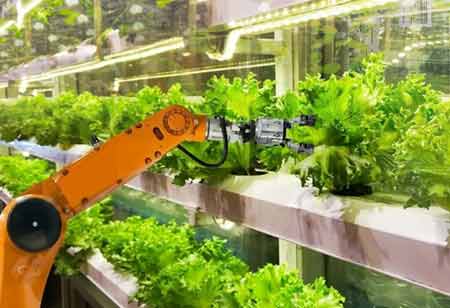Thank you for Subscribing to Agri Business Review Weekly Brief
How Does Vertical Farming Technology Work?
Vertical farming is a growing trend in which crops are grown vertically inside a building.

By
Agri Business Review | Thursday, March 24, 2022
Stay ahead of the industry with exclusive feature stories on the top companies, expert insights and the latest news delivered straight to your inbox. Subscribe today.
Vertical farming is based on controlled environment agriculture, in which cutting-edge technology is used to create optimal conditions for any crop. However, vertical farming is ready to reach new heights thanks to emerging technologies like AI, machine learning, and IoT.
Fremont, CA: Vertical farming is a growing trend in which crops are grown vertically inside a building. The production of crops in controlled conditions, where every aspect affecting their growth is closely monitored and matched to their demands, is what a vertical system entails.
Understanding the technologies that enable vertical farming is the most effective way to describe it. We'll look at how controlled environment agriculture works, how different parameters are controlled, and how emerging technologies like AI, machine learning, and the Internet of Things are driving innovation in indoor crop production in the sections below.
Controlled Environment Agriculture (CEA)
Temperature, carbon dioxide, oxygen, lighting, humidity, nutrient content, pH, insect management, watering, and harvesting are all monitored using smart sensors in vertical farms. Hydroponic, aeroponic, and aquatic cultivation are common in controlled conditions. Furthermore, advanced image and sensor technologies such as cameras and thermal imaging can be used in controlled environment agriculture to monitor plant growth, temperature, and other parameters.
Lighting
Natural light is replaced with artificial lighting in indoor farming, which acts as the crop's sole illumination source. Plant development and yield are influenced by light's color, intensity, and duration. Because each stage of plant development has varied lighting requirements, vertical farming requires a lot of research to find the best performing light source.
CO2 Enrichment for Air Pollution Control
The optimal CO2 concentration for indoor farming is roughly 1000 parts per million; however, these levels can easily fall below 800 parts per million during ventilation and photosynthesis. Carbon dioxide is an essential component of photosynthesis, and even minor changes in its concentration directly impact plant growth and productivity.
Airflow
A vertical farm must have steady airflow for plants to grow properly. Vertical systems use airflow to transport air via filtering devices, reducing humidity, removing heat, and circulating CO2. Unfortunately, heat and humidity build-up in the growing area, make it an ideal breeding ground for bacteria, fungi, and mold, increasing the risk of infection.
IoT stands for Internet of Things.
In the agriculture sector, IoT is already being utilized to increase production, monitor crops, and make farming more efficient. Because the smart sensors used in vertical farming measure every aspect from humidity to pH levels and relay them to the farmers in real-time, IoT allows vertical farming to control the growth environment in which crops are cultivated.
Nurseries and Seedling-Growing Systems
Plant nurseries have long been used in traditional farming to improve crop uniformity, reduce the growing season, and boost crop yields. Vertical farms frequently use plant nurseries to start seeds. Seeds are often sown in Rockwool plugs, irrigated, and then placed in nursery rooms with LED grow lights and climatic settings tailored to the seeds' requirements. When the roots of the seedlings reach the bottom of the Rockwool plugs, they are moved to the vertical racks.
See Also:
Top Hearing Aids Companies ( Lucid Hearing )





